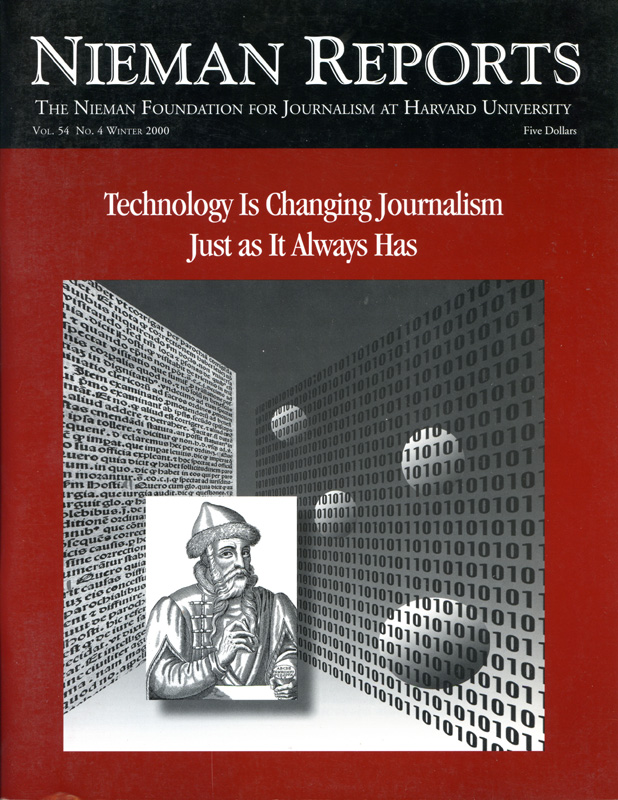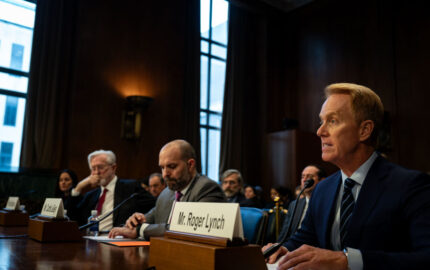
Technology Is Changing Journalism Just as It Always Has
Our journey into the digital future begins with an essay by Tom Regan, associate editor of The Christian Science Monitor’s Web site. His advice: Remember that technology is changing journalism, “as it always has;” wireless is the next publishing realm, and the Web—as a news distribution method—is (almost) already dead.
Increasingly, newspapers are tagging columns, articles and editorials with phone numbers and e-mail addresses to help readers contact reporters and other writers. And that’s great—at least on the surface.
The problem is: Just when are reporters and writers supposed to engage personally any and all who wish to debate, condemn or (God forfend) even praise? There are just 24 hours to a day, at least six to eight of which, as a rule, are devoted to sleeping. Even ink-stained wretches are entitled to a couple of hours a day to tend to family matters or to doing something that isn’t more work.
Moreover, most journalists don’t have clerical assistance, and their days, with some variations, go pretty much like this: They arrive in the newsroom, grab a cup of coffee, read the wires and newspapers, meet with editors, get assignments, read background materials, and go out to cover events. They eat lunch (often at their desks), do phone interviews and additional research to double-check sources for accuracy, write stories, wait for stories to be edited (and, if the editor isn’t satisfied, re-write or do additional reporting), and plan for the next assignment.
While it’s fabulous public relations for newspapers to pretend that they’re part of an interactive medium, they’re really not, at least not in terms of realistically being able to provide the sort of one-on-one attention implicitly promised to readers when they see writers’ e-mail addresses or phone numbers at the end of stories. Such interaction is best accomplished by the likes of C-SPAN and radio and TV call-in shows, which are set up to be interactive.
Finally, it’s not as if readers, disgruntled or otherwise, lack forums for airing their views. Many newspapers have ombudsmen who are intermediaries between the newsroom and the public. They’re supposed to spend time with individual readers and then convey the public’s concerns to the newsroom, often meeting with and interviewing individual editors and writers for explanations about why and how a particular story was written and tracking the ways in which errors were made. At my newspaper in Louisville, Kentucky, The Courier-Journal’s ombudsman—who is a woman, but I am simply not going to call her an “ombudsperson”—writes a regular column published most Sundays, the day of highest circulation, in which she informs the public about the process and reasoning behind certain newsroom decisions. She may conclude that the wrong call was made.
Meanwhile, most newspapers have Letters to the Editor sections in which, at no cost, readers may express their views. At The Courier-Journal, as I suspect at many other papers, letters critical of our editorials and political endorsements are more likely to be published than ones that praise us.
I believe that it’s worse than not responding to the public at all to encourage people to write detailed, thoughtful e-mails and letters to individual reporters and writers with the expectation that they will receive something similar in return. As a columnist, I receive quite a bit of mail. I try to get back to as many people as I can. But more often than not, I can do no better than send out printed postcards that carry my column photo and convey thanks to the reader for taking time to write and an apology for my inability to respond in depth. I do sign the postcards. It’s not ideal. In the end, I am convinced that people get much more mileage writing a letter to the editor than waiting days and even weeks to hear from me—and then only getting a postcard, which realistically is the best that I can do. And letters to the editor do, in fact, make a significant impact on the reporter or writer.
Cyberspace is a wonderful invention, but newspapers really shouldn’t promise more than they can deliver, especially when doing so requires even more from the people who, in addition to traditional reporting and writing, are also now having to meet new expectations created by the computer revolution.
Betty Winston Bayé, a 1991 Nieman Fellow, is editorial writer and columnist at The Courier-Journal in Louisville, Kentucky. This year her book, “Blackbird,” was published by August Press.
The problem is: Just when are reporters and writers supposed to engage personally any and all who wish to debate, condemn or (God forfend) even praise? There are just 24 hours to a day, at least six to eight of which, as a rule, are devoted to sleeping. Even ink-stained wretches are entitled to a couple of hours a day to tend to family matters or to doing something that isn’t more work.
Moreover, most journalists don’t have clerical assistance, and their days, with some variations, go pretty much like this: They arrive in the newsroom, grab a cup of coffee, read the wires and newspapers, meet with editors, get assignments, read background materials, and go out to cover events. They eat lunch (often at their desks), do phone interviews and additional research to double-check sources for accuracy, write stories, wait for stories to be edited (and, if the editor isn’t satisfied, re-write or do additional reporting), and plan for the next assignment.
While it’s fabulous public relations for newspapers to pretend that they’re part of an interactive medium, they’re really not, at least not in terms of realistically being able to provide the sort of one-on-one attention implicitly promised to readers when they see writers’ e-mail addresses or phone numbers at the end of stories. Such interaction is best accomplished by the likes of C-SPAN and radio and TV call-in shows, which are set up to be interactive.
Finally, it’s not as if readers, disgruntled or otherwise, lack forums for airing their views. Many newspapers have ombudsmen who are intermediaries between the newsroom and the public. They’re supposed to spend time with individual readers and then convey the public’s concerns to the newsroom, often meeting with and interviewing individual editors and writers for explanations about why and how a particular story was written and tracking the ways in which errors were made. At my newspaper in Louisville, Kentucky, The Courier-Journal’s ombudsman—who is a woman, but I am simply not going to call her an “ombudsperson”—writes a regular column published most Sundays, the day of highest circulation, in which she informs the public about the process and reasoning behind certain newsroom decisions. She may conclude that the wrong call was made.
Meanwhile, most newspapers have Letters to the Editor sections in which, at no cost, readers may express their views. At The Courier-Journal, as I suspect at many other papers, letters critical of our editorials and political endorsements are more likely to be published than ones that praise us.
I believe that it’s worse than not responding to the public at all to encourage people to write detailed, thoughtful e-mails and letters to individual reporters and writers with the expectation that they will receive something similar in return. As a columnist, I receive quite a bit of mail. I try to get back to as many people as I can. But more often than not, I can do no better than send out printed postcards that carry my column photo and convey thanks to the reader for taking time to write and an apology for my inability to respond in depth. I do sign the postcards. It’s not ideal. In the end, I am convinced that people get much more mileage writing a letter to the editor than waiting days and even weeks to hear from me—and then only getting a postcard, which realistically is the best that I can do. And letters to the editor do, in fact, make a significant impact on the reporter or writer.
Cyberspace is a wonderful invention, but newspapers really shouldn’t promise more than they can deliver, especially when doing so requires even more from the people who, in addition to traditional reporting and writing, are also now having to meet new expectations created by the computer revolution.
Betty Winston Bayé, a 1991 Nieman Fellow, is editorial writer and columnist at The Courier-Journal in Louisville, Kentucky. This year her book, “Blackbird,” was published by August Press.


